MUSIC IN THE COSMOLOGY OF JOHANNES KEPLER (1571–1630)

Bruce Dickey, 2021
This recording is a tribute to Johannes Kepler and a reflection on his ideas about music and cosmology. It attempts to recreate the musical soundscape of Kepler’s world in order to better understand his ideas but also to share his unflagging yearning for harmony, both in the heavens and on earth. Of course, Kepler is justly famous as one of the greatest astronomers of all time. His views were crucial in solidifying the Copernican view of the solar system which displaced the earth from the center of the planetary system, while determining that the planets rotated in elliptical orbits, not perfect circles, as had been previously thought. But Kepler had many interests, ranging from astronomy to astrology, optics, rhetoric, theology, politics and, not least, music. Kepler did not even see astronomy as his highest calling. Only a few weeks after he formulated his theory of the elliptical orbits of planets, he wrote to a friend, “If only God would set me free from astronomy so that I might turn to the care of my work on the harmony of the world.”
It is in his search for harmony that Kepler speaks to us most poignantly as musicians of the 21st century. A deeply religious Protestant, he lived in profoundly troubled times. There were signs all about portending the terrible Thirty-Years War which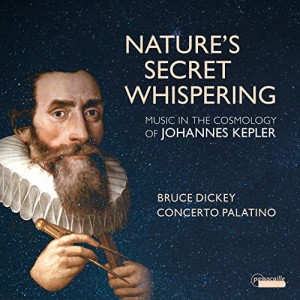 would kill a third of the German population. Indeed, the famous Defenestration of Prague, in which angry Protestants threw two Catholic bureaucrats and their secretary from a third-story window igniting the war, took place only four days before Kepler completed his Harmony of the World. Against this religious and political backdrop Kepler defended his mother against charges of witchcraft (while still believing, himself, in the existence of witches), and espoused the new Copernican conception of the solar system, risking accusations of heresy. Seeking harmony, Kepler found it in two places: in the heavens and in music, holding that those two harmonic models were both reflections of the mind of God. But Kepler did not stop there. He hoped that, having revealed the nature of harmony in nature, he could work toward harmony in the world and a peaceful coexistence of diverse religious views on earth.
would kill a third of the German population. Indeed, the famous Defenestration of Prague, in which angry Protestants threw two Catholic bureaucrats and their secretary from a third-story window igniting the war, took place only four days before Kepler completed his Harmony of the World. Against this religious and political backdrop Kepler defended his mother against charges of witchcraft (while still believing, himself, in the existence of witches), and espoused the new Copernican conception of the solar system, risking accusations of heresy. Seeking harmony, Kepler found it in two places: in the heavens and in music, holding that those two harmonic models were both reflections of the mind of God. But Kepler did not stop there. He hoped that, having revealed the nature of harmony in nature, he could work toward harmony in the world and a peaceful coexistence of diverse religious views on earth.
While Kepler’s views on music were closely tied to mathematics and to his observations of heavenly bodies, he also approached music from a practical perspective. As the famous English 18th-century musical historian Charles Burney said, “The great mathematician and astronomer Kepler, in his ‘Harmonia Mundi’ … speaks upon the subject of Music like a man who had not only thought of it as a science subservient to the laws of calculation, but studied it as an elegant art, and been truly sensible to its powers.”
 Of course, Kepler was well versed in the ancient concepts of cosmic harmony, the music of the spheres, as it was known. It was universally believed by the ancients, that the planets produced tones. Pythagoras demonstrated on the monochord the relationships between string length and pitch that solidified the relationship between mathematics and music, a relationship that underlay Kepler’s life-long search for harmony in his observations of the cosmos. As a writer on music, though, Kepler has often been erroneously depicted as a mere neoplatonic thinker, mostly concerned with abstract archetypes and ancient philosophy. This is contradicted by a look at Kepler’s musical background and by his observations on the music of his day.
Of course, Kepler was well versed in the ancient concepts of cosmic harmony, the music of the spheres, as it was known. It was universally believed by the ancients, that the planets produced tones. Pythagoras demonstrated on the monochord the relationships between string length and pitch that solidified the relationship between mathematics and music, a relationship that underlay Kepler’s life-long search for harmony in his observations of the cosmos. As a writer on music, though, Kepler has often been erroneously depicted as a mere neoplatonic thinker, mostly concerned with abstract archetypes and ancient philosophy. This is contradicted by a look at Kepler’s musical background and by his observations on the music of his day.
Kepler grew up in the musical traditions of Protestantism in Württemberg. From his fifth year he studied German psalmody as well as Latin sequences and hymns. In addition to daily singing, there were weekly theory lessons during which he would have studied counterpoint. It has been said that Kepler continued and deepened his musical understanding in Tübingen during his theological studies. There the academic ordinances prescribed singing three days a week, “so that the students must always study new motets and good songs, and thus keep the exercise of music in practice.” He also participated in performances of music in the church and at private festivities.
As a part of his first job as mathematics teacher in Graz (1594–1600), he taught Virgil and rhetoric, a discipline in which he maintained a strong interest all his life. At this school he would have been exposed to the musical currents that are reflected in our recording. Erasmus Widmann was an organist there, who favored dance styles in his sacred music. Annibale Perini brought Venetian musical practice to Graz. The musical compositions Perini brought from Venice must have included motets of Andrea Gabrieli, who dedicated his First Book of Masses to Karl, the Habsburg archduke resident in Graz, at whose court the Flemish composer Lambert de Sayve served as chapel master from 1583. Karl also had close ties to the
studied counterpoint. It has been said that Kepler continued and deepened his musical understanding in Tübingen during his theological studies. There the academic ordinances prescribed singing three days a week, “so that the students must always study new motets and good songs, and thus keep the exercise of music in practice.” He also participated in performances of music in the church and at private festivities.
As a part of his first job as mathematics teacher in Graz (1594–1600), he taught Virgil and rhetoric, a discipline in which he maintained a strong interest all his life. At this school he would have been exposed to the musical currents that are reflected in our recording. Erasmus Widmann was an organist there, who favored dance styles in his sacred music. Annibale Perini brought Venetian musical practice to Graz. The musical compositions Perini brought from Venice must have included motets of Andrea Gabrieli, who dedicated his First Book of Masses to Karl, the Habsburg archduke resident in Graz, at whose court the Flemish composer Lambert de Sayve served as chapel master from 1583. Karl also had close ties to the 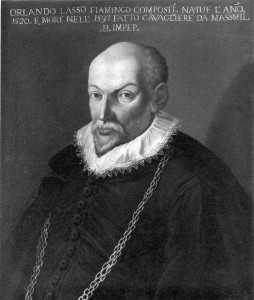 family of Orlando di Lasso, the composer most loved by Kepler. Kepler moved to Prague in 1600, where Emperor Rudolf II cultivated an interest in the occult arts, fostering exact science next to superstition, religious freedom next to zealotry, and refined taste next to brutal sensuality, though Kepler kept himself at some distance from most of these sentiments, saying “I hate all kabbalists.” In Prague, where Rudolf had moved the imperial court in 1586, Kepler likely attended the services at the court chapel, in which a hundred musicians performed music by court composers such as Philippe de Monte and Hans Leo Hassler, as well as Venetian polychoral music.
family of Orlando di Lasso, the composer most loved by Kepler. Kepler moved to Prague in 1600, where Emperor Rudolf II cultivated an interest in the occult arts, fostering exact science next to superstition, religious freedom next to zealotry, and refined taste next to brutal sensuality, though Kepler kept himself at some distance from most of these sentiments, saying “I hate all kabbalists.” In Prague, where Rudolf had moved the imperial court in 1586, Kepler likely attended the services at the court chapel, in which a hundred musicians performed music by court composers such as Philippe de Monte and Hans Leo Hassler, as well as Venetian polychoral music.
In contrast to the ancient philosophers and most of his contemporaries, Kepler did not believe that the planets produced sound in their movements, at least not sound which could be perceived by the human ear. This was because in the universe, or more accurately the solar system, there was no medium which could transport such sound to the human ear. According to him, these sounds could only be heard by the sun, or more accurately by the soul of the sun, since in Kepler’s thinking all heavenly bodies were alive.
It was Kepler’s belief that music, especially polyphonic music as perfected in the last hundred years before him, reflected the celestial harmonies described by the movements of the planets. In attempting to demonstrate these ideas, Kepler makes use of both mathematical proportions and celestial observations. All of the intervals used in music corresponded to simple mathematical proportions, such as 1:2, 3:5, 5:8, 2:3, 3:4, 4:5, 5:6 and so on. In examining the positions and movements of the planets, Kepler discovered virtually the same proportions. One modern scientist has said that Kepler’s hunch and the physical reality have proven to be astonishingly close.
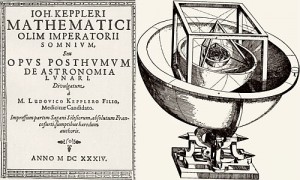
A lot of Kepler’s reasoning relies on the shapes of the planetary orbits. If we relate the speed of a planet’s movement to a musical tone, a planet moving in a circular orbit, as was believed previous to the observations of Tycho Brahe, would produce only one tone. But if the planet moves in an elliptical orbit, its speed, or rather, what is known as its angular velocity, will vary according to its distance from the sun, moving most quickly at the closest point (perihelion) and most slowly at the furthest point (aphelion). Thus, depending on the shape of its orbit, each planet, or better, its ratio of angular velocities at aphelion and perihelion defined a unique interval, and by filling in the notes (speeds) in between, a particular scale or mode as well. Thus Mercury, whose orbit is most elliptical, has the widest interval and thus the most intervening tones, while Venus, as the most circular, sings only one tone. The Earth, nearly as circular, sings two tones a minor second apart (thus MI FA) causing it to sing its music in the Phrygian mode in which this interval is emphasized. Using Tycho’s data, Kepler began to work with pairs of planets. He showed that the speed of Saturn at perihelion, and Jupiter at aphelion, were in the ratio of 1:2, corresponding to an octave. Similarly, the ratio between the speeds of Mars at perihelion and Earth at aphelion was 1:3 (a perfect fifth) and so on. He reasoned that, given an infinity of time, each planet would occupy all possible relationships to the other planets, thus creating all of the harmonies heard in music. But this “music” moved very slowly – billions if not trillions of years for a “cadence” to occur. Man, in creating polyphonic music, especially that in six parts corresponding to the six planets known to him, caused these celestial relationships and cadences to occur within a human span of time.
THE MUSIC
All of the music on this CD, with the single exception, of course, of the newly commissioned work, is music which Kepler either knew, or would likely have known, as it comes from composers in his immediate cultural milieu. The piece of Calliope Tsoupaki, on the other hand, is presented as an opportunity to reflect in a different way on the intersection of cosmology and music. Kepler’s interest in music went beyond the mathematical observations detailed above. He was also interested in rhetoric and spoke movingly about the relationship between musical intervals and the expression of human passion. He felt that, of all the composers of his time, Orlando di Lasso best succeeded in expressing in his music the harmony that he observed in the heavens. What better place to begin our program than Lasso’s magnificent double-choir setting of the offertory Psalm 88, Tui sunt caeli et tua est terra (Thine are the heavens and thine is the earth)? The high and low-choir division is immediately brought into play to depict heaven and earth and the counterpoint is then virtually taken over by an insistent repetitive figure on the word praeparatio serving to underline the imperative of preparing for the coming of the Lord. Toward the end of our CD, as a pendant to Tui sunt caeli, we present Lasso’s splendid 10-part setting of the hymn Aurora lucis rutilat. From its opening image of the glittering dawn with songs of praise echoing through the heavens, the text is full of powerful rhetoric, calling forth a rare richness of musical devices depicting wailing fear, the sting of death, prisoners’ chains, armed sentinels, and the pains of hell. It all comes to a surprisingly quiet end with echoing Amens from the two choirs.
Kepler was particularly taken by Lasso’s five-voice motet In me transierunt. The piece, full of strong emotion, is in the Phrygian mode which emphasizes that half-tone interval MI-FA characterized by Kepler in his planetary analysis as “the song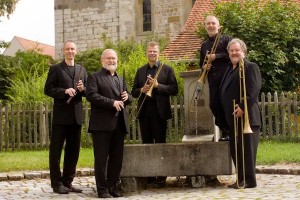 of the earth” – an interval which, in Kepler’s words, makes the mode “sound plaintive, broken, and in a sense lamentable”. He writes that “The Earth sings MI FA MI, so that even from the syllables you may guess that in this home of ours MIsery and FAmine hold sway.” Kepler’s description of the intervalic structure of the opening melody, with its rising sixth and falling second, reveals both his knowledge of musical rhetoric as understood by musicians of his time, and his sensitivity to its effects. He points out the rarity of the ascending minor sixth as an opening interval, and describes the combination of this interval and the following descending second as expressing a deep magnitude of grief or as a “wailing”. This motet was widely known and praised at the time, and was the subject of a celebrated rhetorical analysis by the German theorist Joachim Burmeister. The analysis, published in 1606, was doubtless known to Kepler.
of the earth” – an interval which, in Kepler’s words, makes the mode “sound plaintive, broken, and in a sense lamentable”. He writes that “The Earth sings MI FA MI, so that even from the syllables you may guess that in this home of ours MIsery and FAmine hold sway.” Kepler’s description of the intervalic structure of the opening melody, with its rising sixth and falling second, reveals both his knowledge of musical rhetoric as understood by musicians of his time, and his sensitivity to its effects. He points out the rarity of the ascending minor sixth as an opening interval, and describes the combination of this interval and the following descending second as expressing a deep magnitude of grief or as a “wailing”. This motet was widely known and praised at the time, and was the subject of a celebrated rhetorical analysis by the German theorist Joachim Burmeister. The analysis, published in 1606, was doubtless known to Kepler.
Kepler maintained that the counterpoint best suited to replicating the celestial harmony was that in six parts, corresponding to the six planets known to him. In response to that preference we have chosen a six-part motet of Lasso, Si coelum et coelorum, whose opening rising interval is a rhetorical evocation of the heavens. Here we have decided on an instrumentation of three voices and three instruments in order to demonstrate the complete interchangeability of voices and instruments in the musical practice of Kepler’s day. Singers imitated nature by giving voice to and expressing the meanings of words; instrumentalists by imitating the speech of singers.
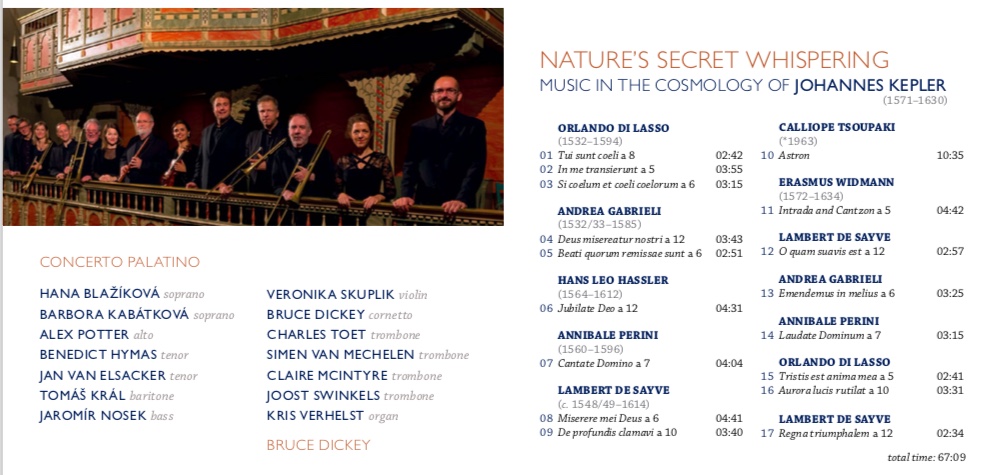
We have also chosen six-part motets of some of Lasso’s colleagues and students, experimenting with different combinations of voices and instruments for each. We perform Andrea Gabrieli’s Beati quorum with instruments alone and his Emendemus in melius, once again with three instruments and three voices. We hope that we have succeeded in making the connection between voices and instruments so seamless that one is not always aware what is being sung and what played. By the time Kepler went to Graz in 1594 to teach mathematics and rhetoric, Lambert de Sayve, who taught the choirboys there until 1582, would have been gone for over a decade. But Lambert then became choirmaster in the chapel of Archduke Matthias of Austria (the brother of Emperor Rudolf II). When Matthias succeeded his brother Rudolf as emperor in 1612, Lambert became master of the imperial chapel. In the final piece on our program Lambert celebrates in grandiose fashion the coronation of Matthias as emperor. Kepler could not have been unacquainted with such an important musician in his immediate sphere. We imagine Kepler would have loved Lambert’s powerfully expressive six-voice motet Miserere mei Deus with its achingly beautiful harmonic usage and effective use of rhetorical devices such as the huge downward leaps at et in umbra, followed by upward-moving passaggi on sperabo, and the delicate harmonic shifts at iniquitas. It is a masterful work. We have chosen to reveal all of its powerful musical rhetoric with a setting for voices alone.

Kaiser Matthias
When Kepler arrived in Graz, Annibale Perini was organist at the Protestant collegiate church there. He had arrived in Graz from Venice in about 1575. It is thought he was a nephew of Annibale Padovano, and like his presumed uncle, Perini was active in importing the Venetian style to Graz. The seven- part Cantate Domino on our program is one of his finest works and is found in six sources. His Laudate Dominum, also for seven voices, is less complex contrapuntally, but is still rich in the rhythm and drama of its text setting, which we have chosen to amplify in a setting for seven voices and seven instruments.
We do not know if Kepler ever met Hans Leo Hassler, but he can hardly have avoided knowing his music. Hassler had studied in Venice with Andrea Gabrieli and was one of the principal composers responsible for the dissemination of the Venetian style north of the Alps. Around the turn of the century, Hassler’s vocal works were appearing in important anthologies and were widely available. He worked in Augsburg and Nuremberg, but was always in close contact with Rudolf II for whom he held the post of “Kaiserlichen Hofdiener”. At Rudolf’s court in Prague, Kepler must have heard polychoral compositions of Hassler such as the splendidly Venetian triple-choir motet Jubilate Deo, and the surperb three-choir setting of Deus misereatur nostri of Andrea Gabrieli.
From a desire to provide a counter-weight and contrast to the polyphony of Kepler’s world, and to provide an opportunity for a different kind of reflection on music and cosmology, we have asked Calliope Tsoupaki, named in 2019 “composer laureate” of the Netherlands, to write a new work inspired by Kepler. She responded with a work called Astron, based on an Orphic hymn “To the Stars”. It is a powerful, almost ritualistic invocation to the stars written in the manner of an imagined Greek chorus. A mixed group of singers forms the chorus, led by a soprano soloist in the role of the Coryphaeus. The group of singers responds to her with powerfully homophonic music, occasionally giving way to unexpected moments of serene harmony. An instrumental group responds to the singers with solos of the cornetto and violin supported by exclamations from the four trombones ranging from violent roars to quiet solemnity.
